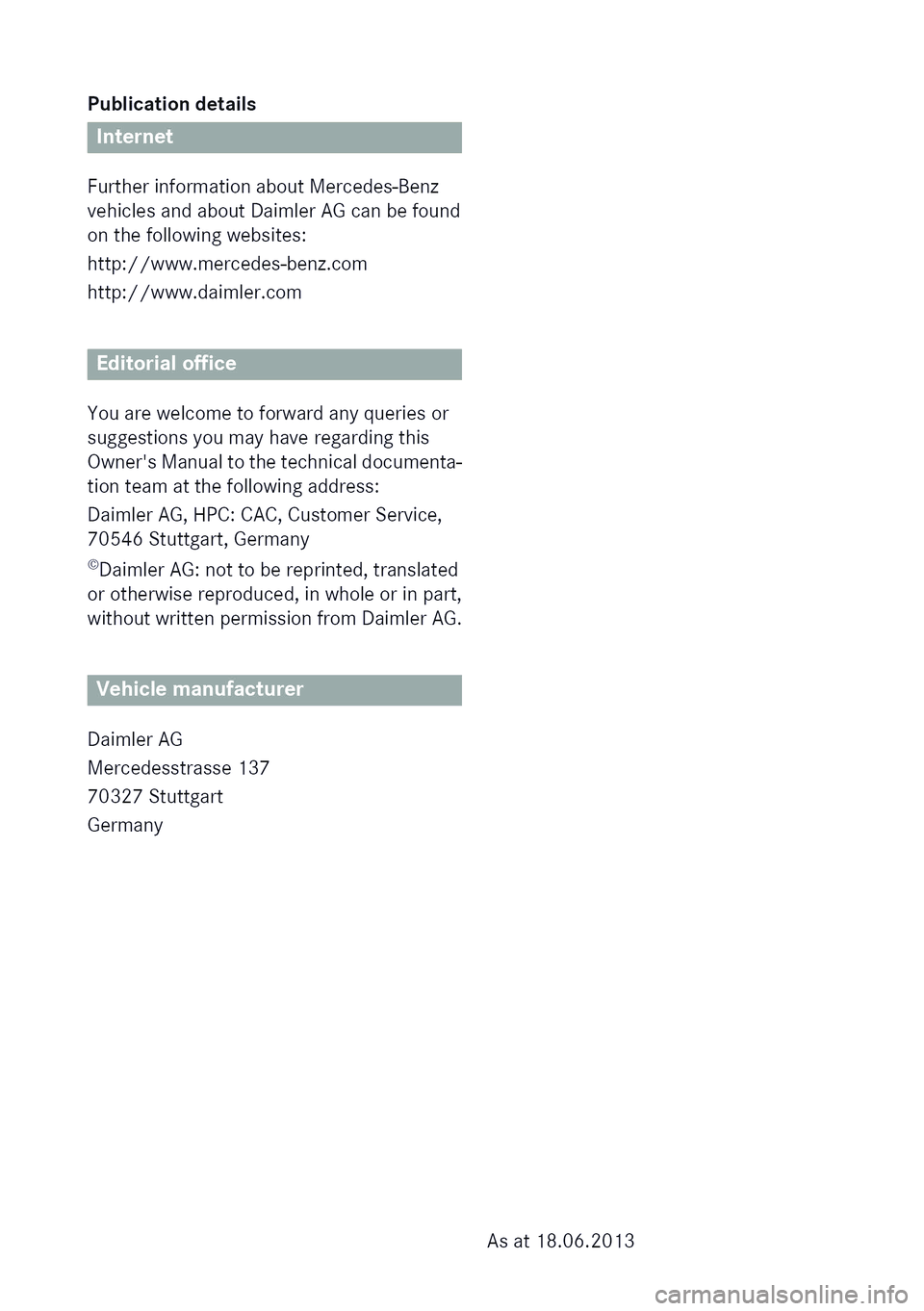MERCEDES-BENZ GLA SUV 2013 Owners Manual
Manufacturer: MERCEDES-BENZ, Model Year: 2013, Model line: GLA SUV, Model: MERCEDES-BENZ GLA SUV 2013Pages: 401, PDF Size: 11.9 MB
Page 391 of 401
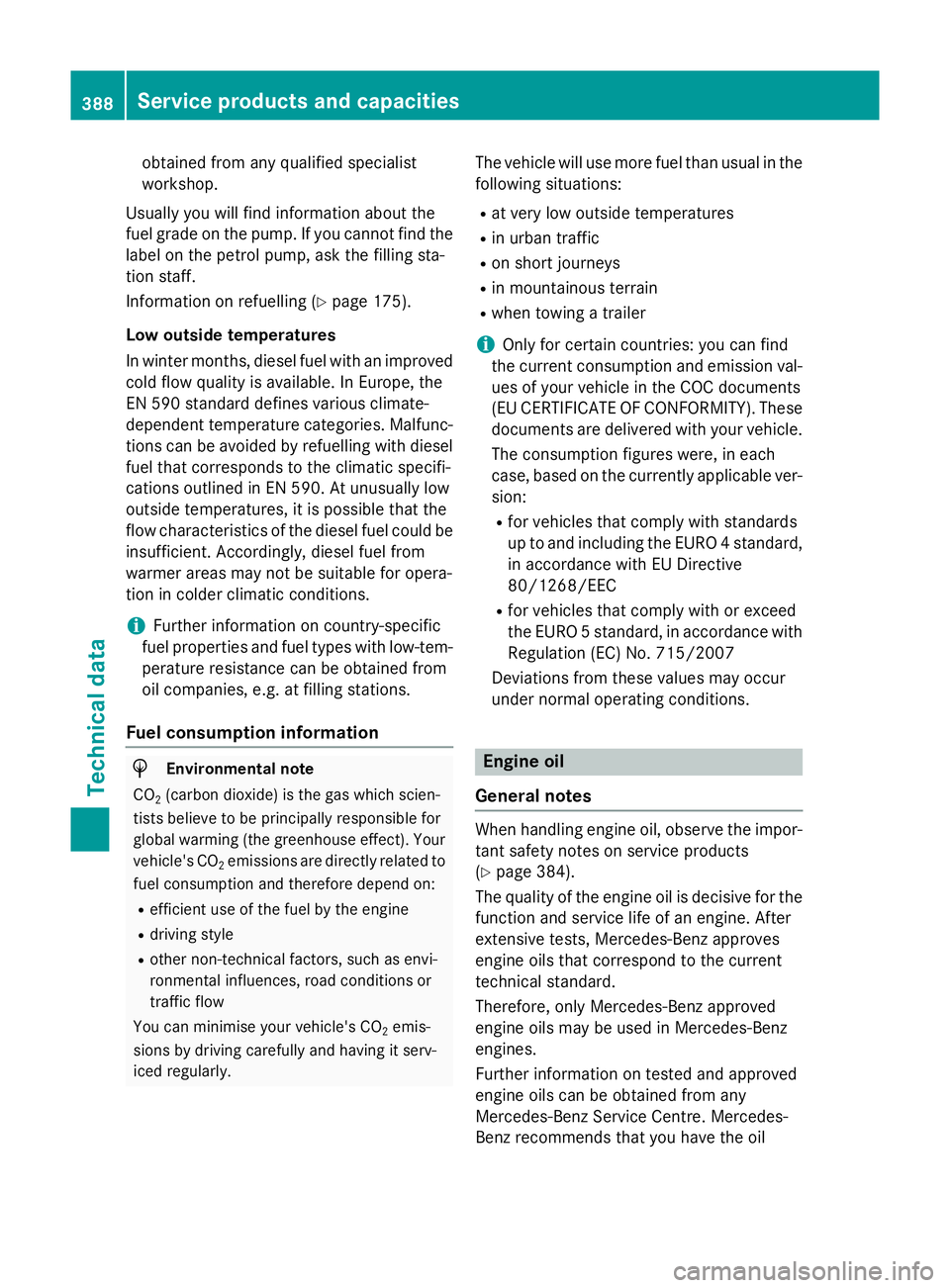
obtained from any qualified specialist
workshop.
Usually you will find information about the
fuel grade on the pump. If you cannot find the label on the petrol pump, ask the filling sta-
tion staff.
Information on refuelling (Y page 175).
Low outside temperatures
In winter months, diesel fuel with an improved cold flow quality is available. In Europe, the
EN 590 standard defines various climate-
dependent temperature categories. Malfunc-
tions can be avoided by refuelling with diesel
fuel that corresponds to the climatic specifi-
cations outlined in EN 590. At unusually low
outside temperatures, it is possible that the
flow characteristics of the diesel fuel could be insufficient. Accordingly, diesel fuel from
warmer areas may not be suitable for opera-
tion in colder climatic conditions.
i Further information on country-specific
fuel properties and fuel types with low-tem-
perature resistance can be obtained from
oil companies, e.g. at filling stations.
Fuel consumption information H
Environmental note
CO 2(carbon dioxide) is the gas which scien-
tists believe to be principally responsible for
global warming (the greenhouse effect). Your
vehicle's CO 2emissions are directly related to
fuel consumption and therefore depend on:
R efficient use of the fuel by the engine
R driving style
R other non-technical factors, such as envi-
ronmental influences, road conditions or
traffic flow
You can minimise your vehicle's CO 2emis-
sions by driving carefully and having it serv-
iced regularly. The vehicle will use more fuel than usual in the
following situations:
R at very low outside temperatures
R in urban traffic
R on short journeys
R in mountainous terrain
R when towing a trailer
i Only for certain countries: you can find
the current consumption and emission val-
ues of your vehicle in the COC documents
(EU CERTIFICATE OF CONFORMITY). These documents are delivered with your vehicle.
The consumption figures were, in each
case, based on the currently applicable ver- sion:
R for vehicles that comply with standards
up to and including the EURO 4 standard, in accordance with EU Directive
80/1268/EEC
R for vehicles that comply with or exceed
the EURO 5 standard, in accordance with
Regulation (EC) No. 715/2007
Deviations from these values may occur
under normal operating conditions. Engine oil
General notes When handling engine oil, observe the impor-
tant safety notes on service products
(Y page 384).
The quality of the engine oil is decisive for the
function and service life of an engine. After
extensive tests, Mercedes-Benz approves
engine oils that correspond to the current
technical standard.
Therefore, only Mercedes-Benz approved
engine oils may be used in Mercedes-Benz
engines.
Further information on tested and approved
engine oils can be obtained from any
Mercedes-Benz Service Centre. Mercedes-
Benz recommends that you have the oil 388
Service products and capacitiesTechnical data
Page 392 of 401
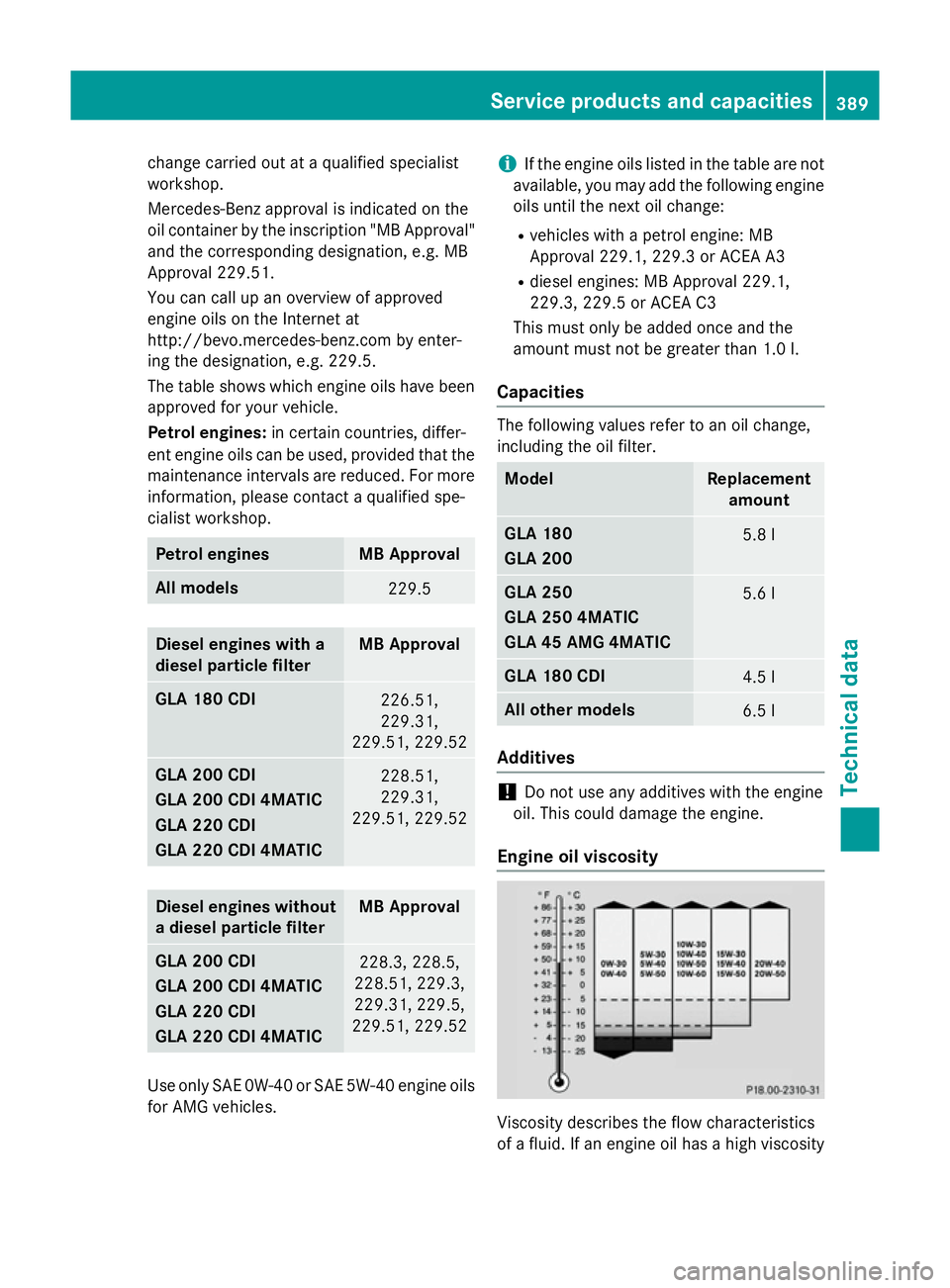
change carried out at a qualified specialist
workshop.
Mercedes-Benz approval is indicated on the
oil container by the inscription "MB Approval"
and the corresponding designation, e.g. MB
Approval 229.51.
You can call up an overview of approved
engine oils on the Internet at
http://bevo.mercedes-benz.co mby enter-
ing the designation, e.g. 229.5.
The table shows which engine oils have been
approved for your vehicle.
Petrol engines: in certain countries, differ-
ent engine oils can be used, provided that the
maintenance intervals are reduced. For more information, please contact a qualified spe-
cialist workshop. Petrol engines MB Approval
All models
229.5
Diesel engines with a
diesel particle filter MB Approval
GLA 180 CDI
226.51,
229.31,
229.51, 229.52 GLA 200 CDI
GLA 200 CDI 4MATIC
GLA 220 CDI
GLA 220 CDI 4MATIC
228.51,
229.31,
229.51, 229.52 Diesel engines without
a diesel particle filter MB Approval
GLA 200 CDI
GLA 200 CDI 4MATIC
GLA 220 CDI
GLA 220 CDI 4MATIC
228.3, 228.5,
228.51, 229.3,
229.31, 229.5,
229.51, 229.52 Use only SAE 0W-4
0or SAE 5W-40 engine oils
for AMG vehicles. i
If the engine oils listed in the table are not
available, you may add the following engine
oils until the next oil change:
R vehicles with a petrol engine: MB
Approval 229.1, 229.3 or ACEA A3
R diesel engines: MB Approval 229.1,
229.3, 229.5 or ACEA C3
This must only be added once and the
amount must not be greater than 1.0 l.
Ca pacities The following values refer to an oil change,
including the oil filter.
Model Replacement
amount GLA 180
GLA 200
5.8 l
GLA 250
GLA 250 4MATIC
GLA 45 AMG 4MATIC
5.6 l
GLA 180 CDI
4.5 l
All other models
6.5 l
Additives
!
Do not use any additives with the engine
oil. This could damage the engine.
Engine oil viscosity Viscosity describes the flow characteristics
of a fluid. If an engine oil has a high viscosityService products and capacities
389Technical data Z
Page 393 of 401
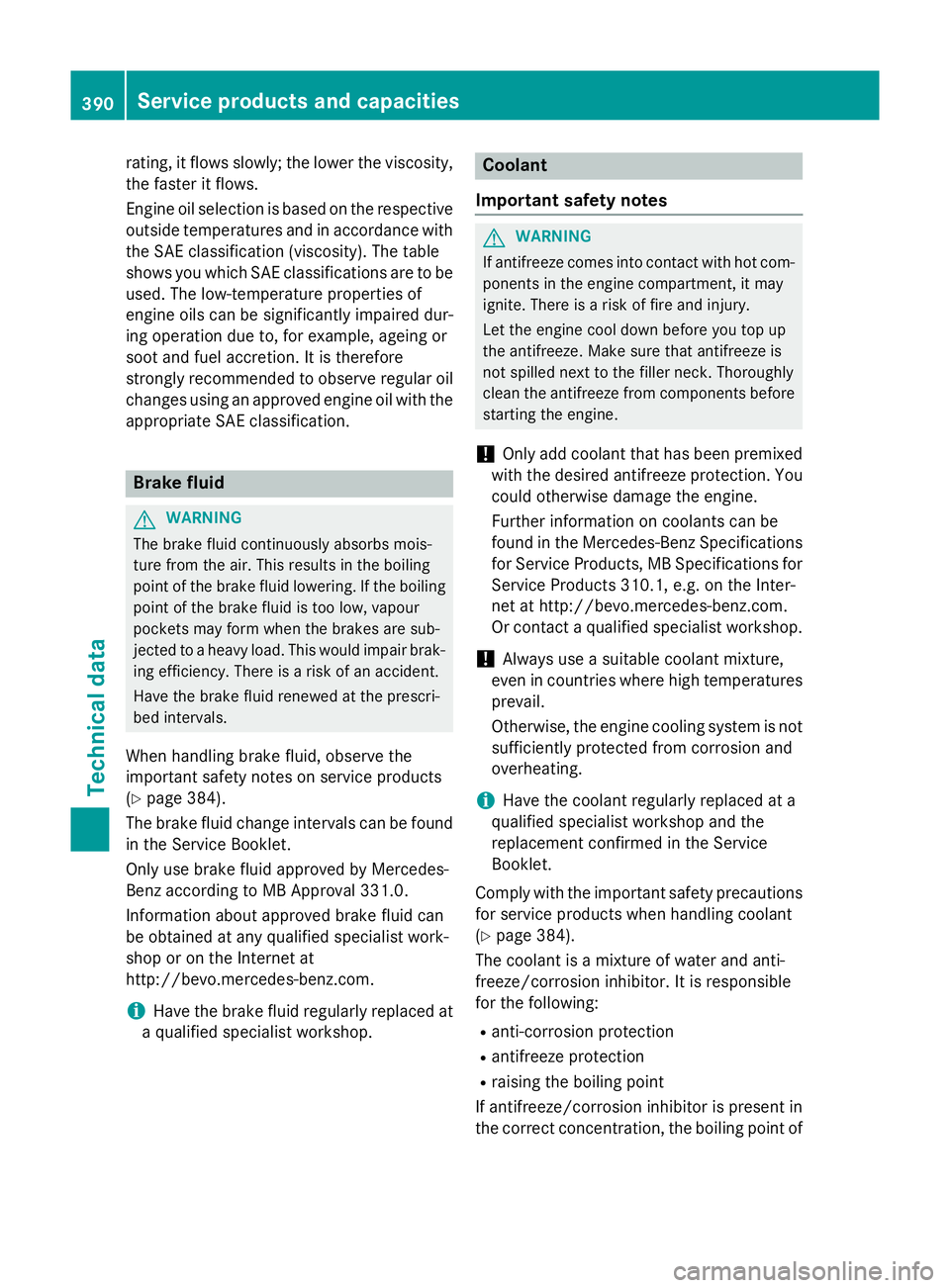
rating, it flows slowly; the lower the viscosity,
the faster it flows.
Engine oil selection is based on the respective outside temperatures and in accordance with
the SAE classification (viscosity). The table
shows you which SAE classifications are to be
used. The low-temperature properties of
engine oils can be significantly impaired dur-
ing operation due to, for example, ageing or
soot and fuel accretion. It is therefore
strongly recommended to observe regular oil changes using an approved engine oil with the
appropriate SAE classification. Brake fluid
G
WARNING
The brake fluid continuously absorbs mois-
ture from the air. This results in the boiling
point of the brake fluid lowering. If the boiling
point of the brake fluid is too low, vapour
pockets may form when the brakes are sub-
jected to a heavy load. This would impair brak- ing efficiency. There is a risk of an accident.
Have the brake fluid renewed at the prescri-
bed intervals.
When handling brake fluid, observe the
important safety notes on service products
(Y page 384).
The brake fluid change intervals can be found in the Service Booklet.
Only use brake fluid approved by Mercedes-
Benz according to MB Approval 331.0.
Information about approved brake fluid can
be obtained at any qualified specialist work-
shop or on the Internet at
http://bevo.mercedes-benz.com.
i Have the brake fluid regularly replaced at
a qualified specialist workshop. Coolant
Important safety notes G
WARNING
If antifreeze comes into contact with hot com- ponents in the engine compartment, it may
ignite. There is a risk of fire and injury.
Let the engine cool down before you top up
the antifreeze. Make sure that antifreeze is
not spilled next to the filler neck. Thoroughly
clean the antifreeze from components before
starting the engine.
! Only add coolant that has been premixed
with the desired antifreeze protection. You
could otherwise damage the engine.
Further information on coolants can be
found in the Mercedes-Benz Specifications for Service Products, MB Specifications for Service Products 310.1, e.g. on the Inter-
net at http://bevo.mercedes-benz.com.
Or contact a qualified specialist workshop.
! Always use a suitable coolant mixture,
even in countries where high temperatures prevail.
Otherwise, the engine cooling system is not
sufficiently protected from corrosion and
overheating.
i Have the coolant regularly replaced at a
qualified specialist workshop and the
replacement confirmed in the Service
Booklet.
Comply with the important safety precautions for service products when handling coolant
(Y page 384).
The coolant is a mixture of water and anti-
freeze/corrosion inhibitor. It is responsible
for the following:
R anti-corrosion protection
R antifreeze protection
R raising the boiling point
If antifreeze/corrosion inhibitor is present in
the correct concentration, the boiling point of 390
Service products and capacitiesTechnical data
Page 394 of 401
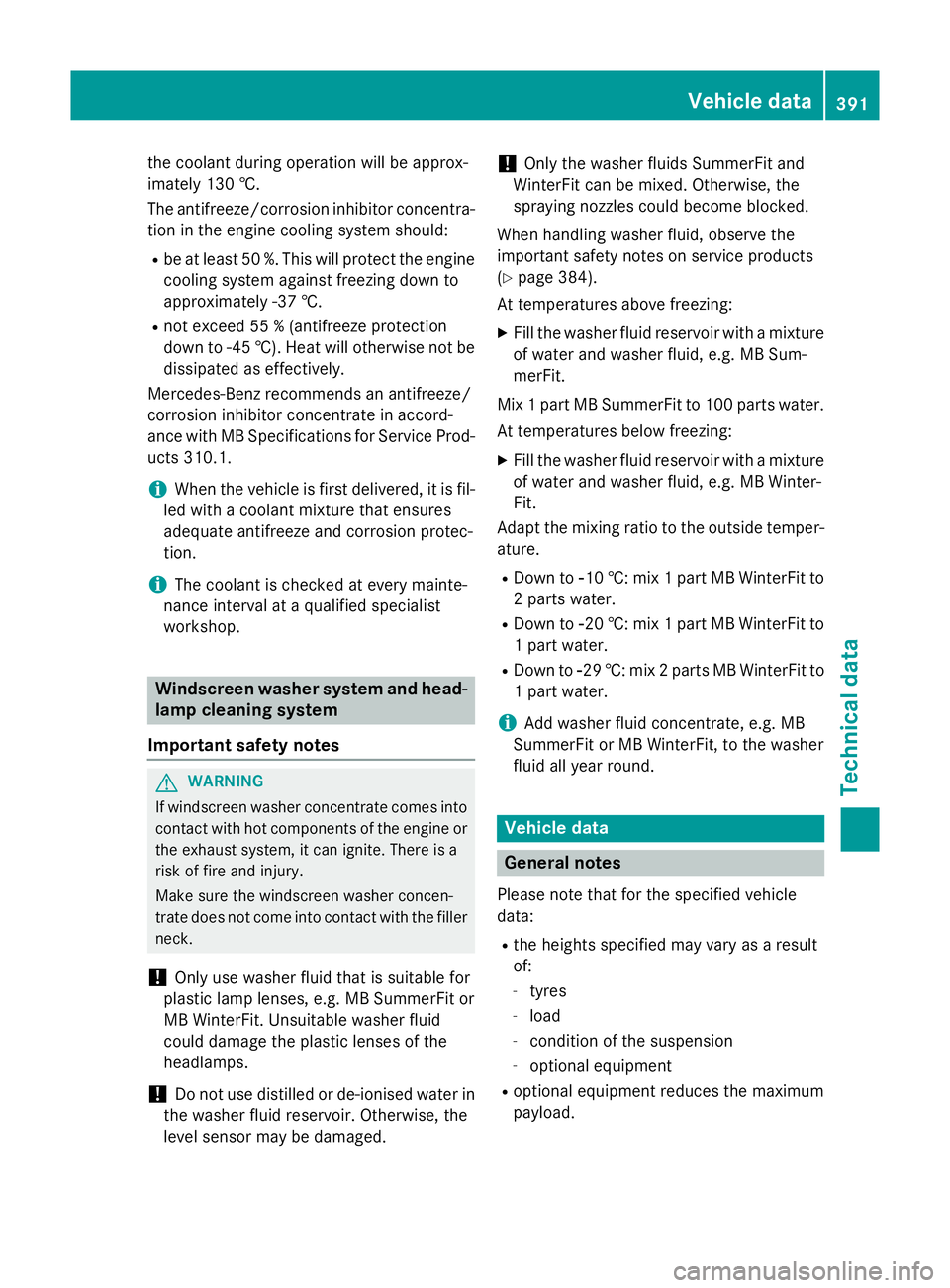
the coolant during operation will be approx-
imately 130 †.
The antifreeze/corrosion inhibitor concentra- tion in the engine cooling system should:
R be at least 50 %. This will protect the engine
cooling system against freezing down to
approximately -37 †.
R not exceed 55 % (antifreeze protection
down to -45 †). Heat will otherwise no t be
dissipated as effectively.
Mercedes-Benz recommends an antifreeze/
corrosion inhibitor concentrate in accord-
ance with MB Specifications for Service Prod-
ucts 310.1.
i When the vehicle is first delivered, it is fil-
led with a coolant mixture that ensures
adequate antifreeze and corrosion protec-
tion.
i The coolant is checked at every mainte-
nance interval at a qualified specialist
workshop. Windscreen washer system and head-
lamp cleaning system
Important safety notes G
WARNING
If windscreen washer concentrate comes into contact with hot components of the engine or
the exhaust system, it can ignite. There is a
risk of fire and injury.
Make sure the windscreen washer concen-
trate does not come into contact with the filler neck.
! Only use washer fluid that is suitable for
plastic lamp lenses, e.g. MB SummerFit or
MB WinterFit. Unsuitable washer fluid
could damage the plastic lenses of the
headlamps.
! Do not use distilled or de-ionised water in
the washer fluid reservoir. Otherwise, the
level sensor may be damaged. !
Only the washer fluids SummerFit and
WinterFit can be mixed. Otherwise, the
spraying nozzles could become blocked.
When handling washer fluid, observe the
important safety notes on service products
(Y page 384).
At temperatures above freezing:
X Fill the washer fluid reservoir with a mixture
of water and washer fluid, e.g. MB Sum-
merFit.
Mix 1 part MB SummerFit to 100 parts water.
At temperatures below freezing:
X Fill the washer fluid reservoir with a mixture
of water and washer fluid, e.g. MB Winter-
Fit.
Adapt the mixing ratio to the outside temper-
ature.
R Down to Ò10 †: mix 1 part MB WinterFit to
2 parts water.
R Down to Ò20 †: mix 1 part MB WinterFit to
1 part water.
R Down to Ò29 †: mix 2 parts MB WinterFit to
1 part water.
i Add washer fluid concentrate, e.g. MB
SummerFit or MB WinterFit, to the washer
fluid all year round. Vehicle data
General notes
Please note that for the specified vehicle
data:
R the heights specified may vary as a result
of:
- tyres
- load
- condition of the suspension
- optional equipment
R optional equipment reduces the maximum
payload. Vehicle data
391Technical data Z
Page 395 of 401

R
vehicle-specific weight information can be
found on the vehicle identification plate
(Y page 384).
R only for certain countries: you can find vehi-
cle-specific vehicle data in the COC docu-
ments (Certificate of Conformity). These
documents are delivered with your vehicle. Dimensions and weights
Model
: :
Maxi- mum
head- room ;
;
Opening height AMG vehicles
1866 mm 2019 mm
All other models
1876 mm 2045 mm
Missing values were not available at the time
of going to print. AMG vehicles
Vehicle length
4445 mm
Vehicle width including
exterior mirrors
2022 mm
Vehicle width excluding
exterior mirrors
1805 mm
Vehicle height
1479 mm
Wheelbase
2699 mm
Maximum roof load
100 kg All other models
Vehicle length
4417 mm
Vehicle width including
exterior mirrors
2022 mm
Vehicle width excluding
exterior mirrors
1804 mm
Vehicle height
1494 mm
Wheelbase
2699 mm
Model Maximum roof
load GLA 180
GLA 180 CDI
All other models
75 kg
Model Maximum boot
load GLA 180
GLA 180 CDI
All other models
100 kg
Vehicle data for off-road driving
Maximum water depth
! The water depth must not exceed the
specified value. Note that the permissible
water depth is less in flowing water. 392
Vehicle data for off-road drivingTechnical data
Page 396 of 401
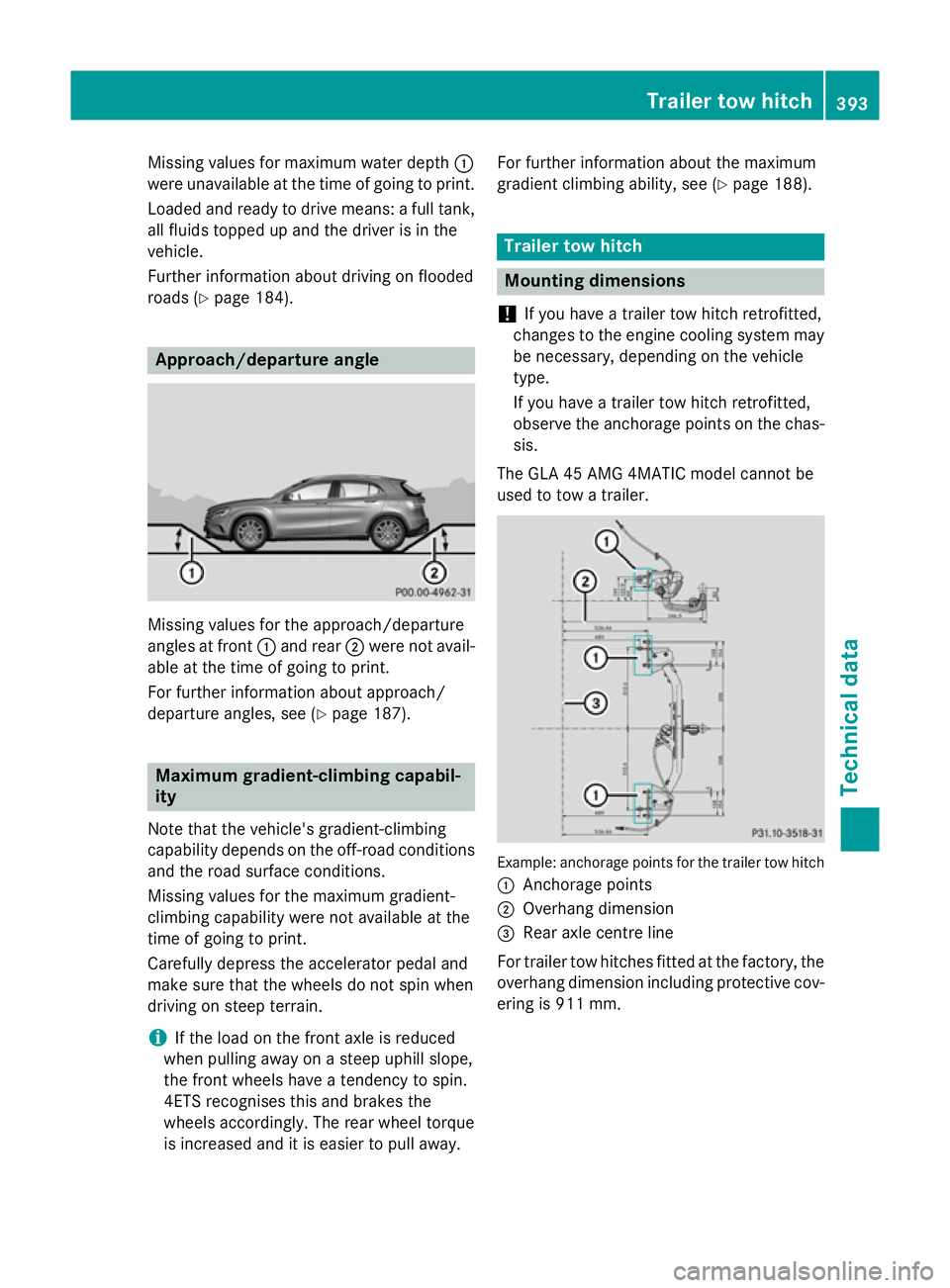
Missing values for maximum water depth
:
were unavailable at the time of going to print.
Loaded and ready to drive means: a full tank,
all fluids topped up and the driver is in the
vehicle.
Further information about driving on flooded
roads (Y page 184). Approach/departure angle
Missing values for the approach/departure
angles at front
:and rear ;were not avail-
able at the time of going to print.
For further information about approach/
departure angles, see (Y page 187).Maximum gradient-climbing capabil-
ity
Note that the vehicle's gradient-climbing
capability depends on the off-road conditions
and the road surface conditions.
Missing values for the maximum gradient-
climbing capability were not available at the
time of going to print.
Carefully depress the accelerator pedal and
make sure that the wheels do not spin when
driving on steep terrain.
i If the load on the front axle is reduced
when pulling away on a steep uphill slope,
the front wheels have a tendency to spin.
4ETS recognises this and brakes the
wheels accordingly. The rear wheel torque
is increased and it is easier to pull away. For further information about the maximum
gradient climbing ability, see (Y
page 188). Trailer tow hitch
Mounting dimensions
! If you have a trailer tow hitch retrofitted,
changes to the engine cooling system may
be necessary, depending on the vehicle
type.
If you have a trailer tow hitch retrofitted,
observe the anchorage points on the chas- sis.
The GLA 45 AMG 4MATIC model cannot be
used to tow a trailer. Example: anchorage points for the trailer tow hitch
: Anchorage points
; Overhang dimension
= Rear axle centre line
For trailer tow hitches fitted at the factory, the
overhang dimension including protective cov- ering is 911 mm. Trailer tow hitch
393Technical data Z
Page 397 of 401
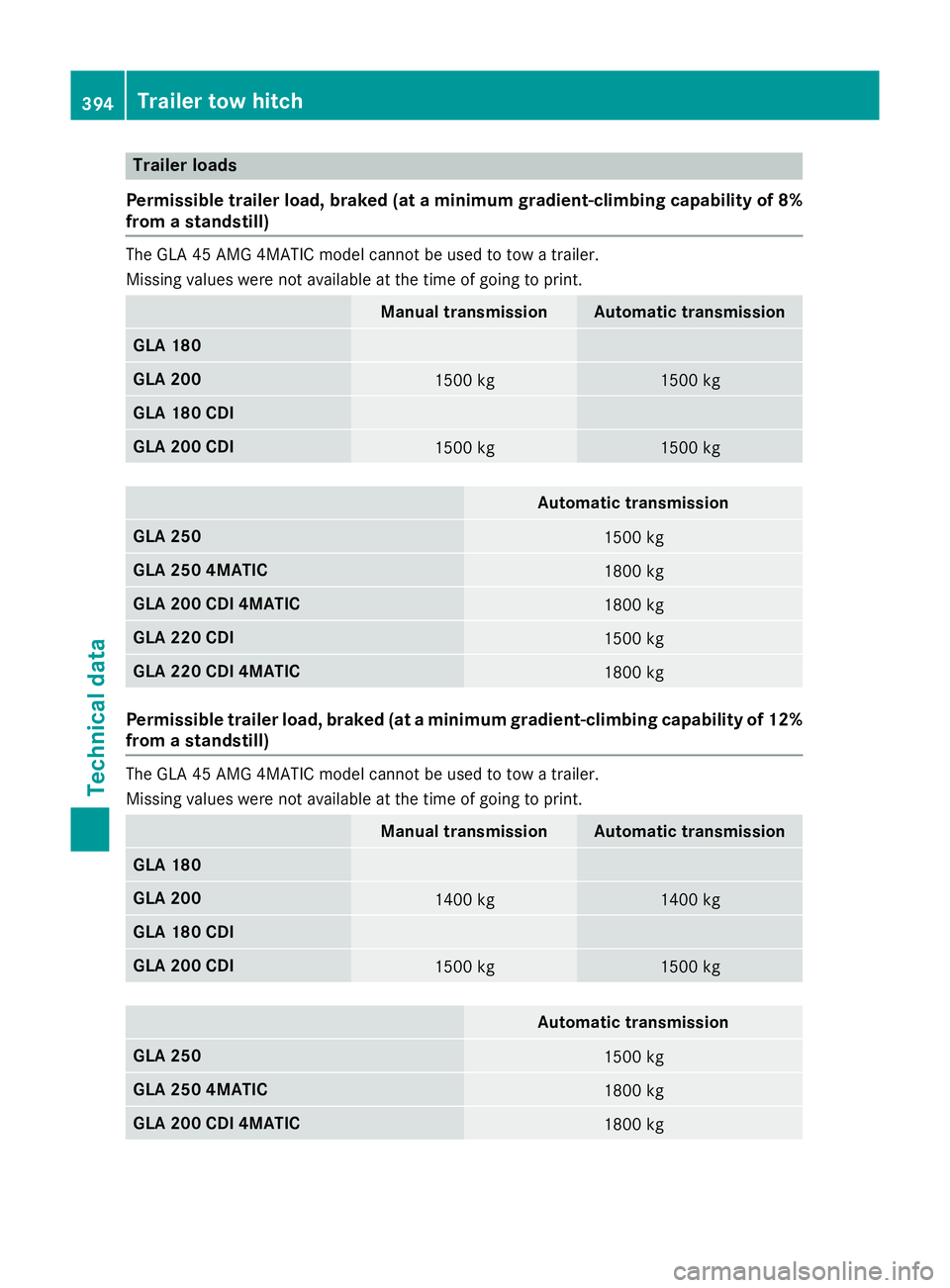
Trailer loads
Permissible trailer load, braked (at a minimum gradient-climbing capability of 8%
from a standstill) The GLA 45 AMG 4MATIC model cannot be used to tow a trailer.
Missing values were not available at the time of going to print. Manual transmission Automatic transmission
GLA 180
GLA 200
1500 kg 1500 kg
GLA 180 CDI
GLA 200 CDI
1500 kg 1500 kg
Automatic transmission
GLA 250
1500 kg
GLA 250 4MATIC
1800 kg
GLA 200 CDI 4MATIC
1800 kg
GLA 220 CDI
1500 kg
GLA 220 CDI 4MATIC
1800 kg
Permissible trailer load, braked (at a minimum gradient-climbing capability of 12%
from a standstill) The GLA 45 AMG 4MATIC model cannot be used to tow a trailer.
Missing values were not available at the time of going to print.
Manual transmission Automatic transmission
GLA 180
GLA 200
1400 kg 1400 kg
GLA 180 CDI
GLA 200 CDI
1500 kg 1500 kg
Automatic transmission
GLA 250
1500 kg
GLA 250 4MATIC
1800 kg
GLA 200 CDI 4MATIC
1800 kg394
Trailer tow hitchTechnical data
Page 398 of 401
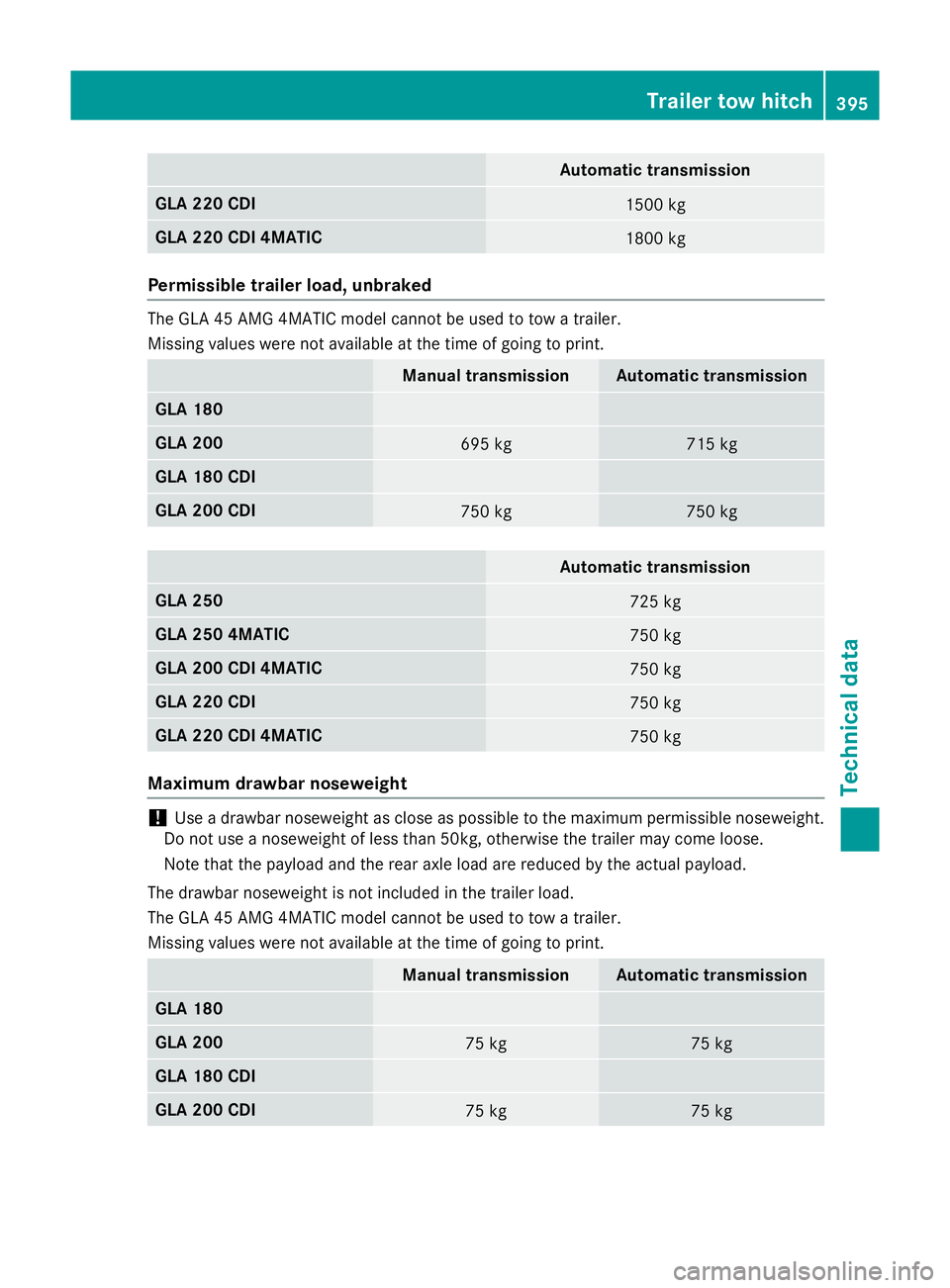
Automatic transmission
GLA 220 CDI
1500 kg
GLA 220 CDI 4MATIC
1800 kg
Permissible trailer load, unbraked
The GLA 45 AMG 4MATIC model cannot be used to tow a trailer.
Missing values were not available at the time of going to print.
Manual transmission Automatic transmission
GLA 180
GLA 200
695 kg 715 kg
GLA 180 CDI
GLA 200 CDI
750 kg 750 kg
Automatic transmission
GLA 250
725 kg
GLA 250 4MATIC
750 kg
GLA 200 CDI 4MATIC
750 kg
GLA 220 CDI
750 kg
GLA 220 CDI 4MATIC
750 kg
Maximum drawbar noseweight
!
Use a drawbar noseweight as close as possible to the maximum permissible noseweight.
Do not use a noseweight of less than 50kg, otherwise the trailer may come loose.
Note that the payload and the rear axle load are reduced by the actual payload.
The drawbar noseweight is not included in the trailer load.
The GLA 45 AMG 4MATIC model cannot be used to tow a trailer.
Missing values were not available at the time of going to print. Manual transmission Automatic transmission
GLA 180
GLA 200
75 kg 75 kg
GLA 180 CDI
GLA 200 CDI
75 kg 75 kgTrailer tow hitch
395Technical data Z
Page 399 of 401
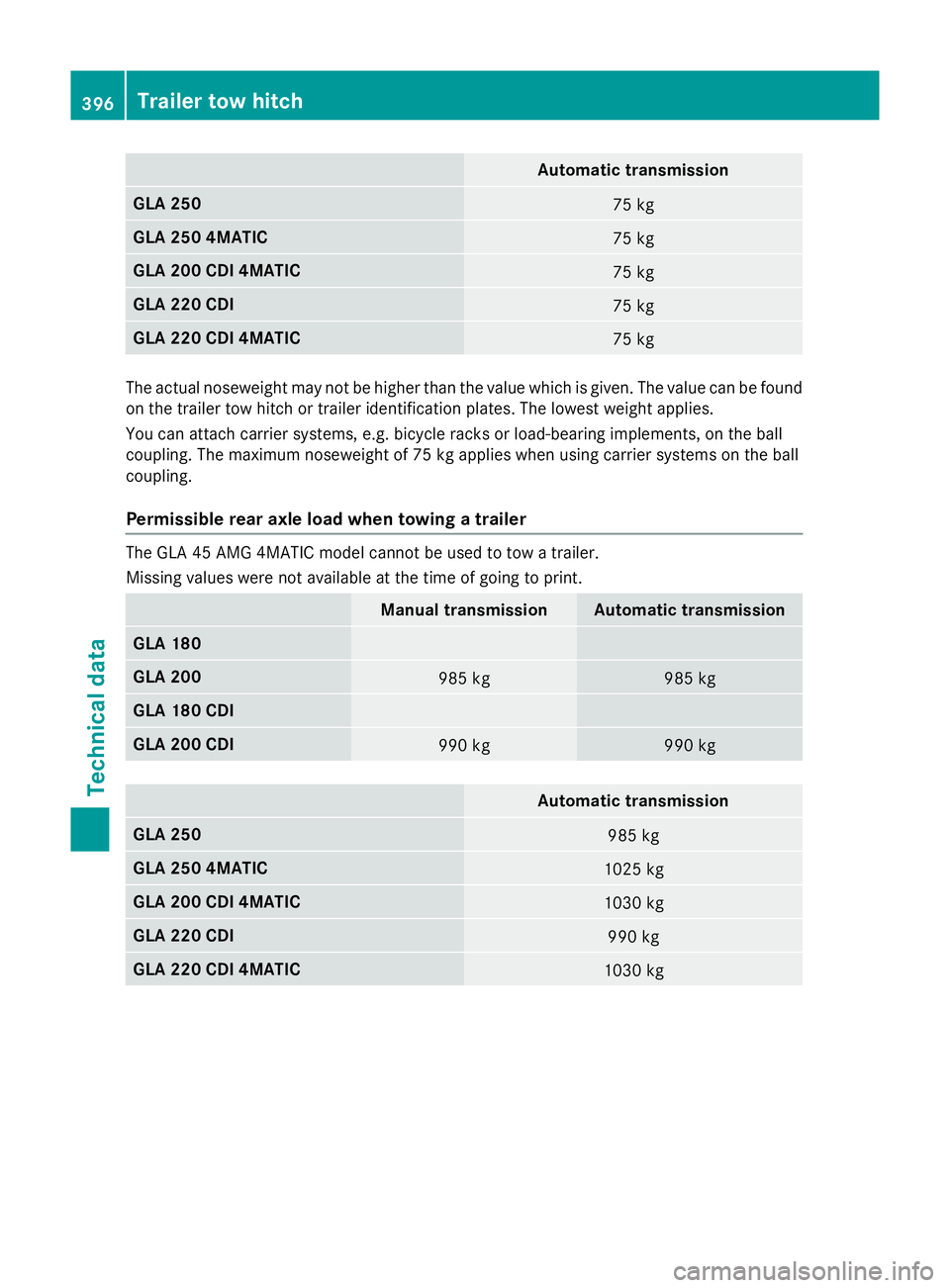
Automatic transmission
GLA 250
75 kg
GLA 250 4MATIC
75 kg
GLA 200 CDI 4MATIC
75 kg
GLA 220 CDI
75 kg
GLA 220 CDI 4MATIC
75 kg
The actual noseweight may not be higher than the value which is given. The value can be found
on the trailer tow hitch or trailer identification plates. The lowest weight applies.
You can attach carrier systems, e.g. bicycle racks or load-bearing implements, on the ball
coupling. The maximum noseweight of 75 kg applies when using carrier systems on the ball
coupling.
Permissible rear axle load when towing a trailer The GLA 45 AMG 4MATIC model cannot be used to tow a trailer.
Missing values were not available at the time of going to print. Manual transmission Automatic transmission
GLA 180
GLA 200
985 kg 985 kg
GLA 180 CDI
GLA 200 CDI
990 kg 990 kg
Automatic transmission
GLA 250
985 kg
GLA 250 4MATIC
1025 kg
GLA 200 CDI 4MATIC
1030 kg
GLA 220 CDI
990 kg
GLA 220 CDI 4MATIC
1030 kg396
Trailer tow hitchTechnical data
Page 400 of 401
